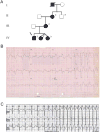Whole exome sequencing identifies the TNNI3K gene as a cause of familial conduction system disease and congenital junctional ectopic tachycardia
- PMID: 25791106
- PMCID: PMC5938092
- DOI: 10.1016/j.ijcard.2015.03.130
Whole exome sequencing identifies the TNNI3K gene as a cause of familial conduction system disease and congenital junctional ectopic tachycardia
Keywords: Exome sequencing; Junctional ectopic tachycardia; TNNI3K.
Conflict of interest statement
The authors report no relationships that could be construed as a con-flict of interest.
Figures


References
-
- Villain E, Vetter VL, Garcia JM, et al. Evolving concepts in the management of congenital junctional ectopic tachycardia. A multicenter study. Circulation. 1990;81:1544–1549. - PubMed
-
- Srour M, Putorti ML, Schwartzentruber J, et al. Mutations in riboflavin transporter present with severe sensory loss and deafness in childhood. Muscle Nerve. 2014;50:775–779. - PubMed
-
- Lai ZF, Chen YZ. Evidence, hypotheses and significance of MAP kinase TNNI3K interacting with its partners. World J Hypertens. 2012;2:22–28.
Publication types
MeSH terms
Substances
Grants and funding
LinkOut - more resources
Full Text Sources
Other Literature Sources
Molecular Biology Databases

